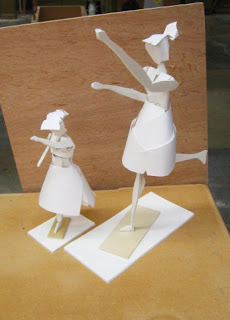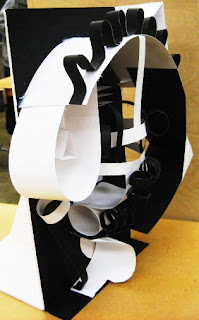Today's Class- We opened by looking at the foam core relief projects that were due today, then we moved on to something new. The topic was Canons of Proportion- a concept of having a specific set of proportions for portraying figures in art. It might be a rule in a society (like the Ancient Egyptians and all figures based on multiples of the widths of the figure's fists) or of a period (such as Classical Greek idealized ratios of head to body that changed over the centuries), or even temporary trends (like the odd exaggerations of the Italian Mannerist period, which sat between the anatomical accuracy of the Renaissance and the extreme accuracy of the Italian Baroque). Also brought up contemporary examples like the sometimes extreme photo shopped advertisements, as in the example below. I showed some examples of all of these in slides, discussed the art of each period, then we went on to start a new portfolio exercise/graded project.
How to make this up- Find a photo that includes a whole human figure, head to toe. The pose doesn't matter, nor gender, amount of clothes, just as long as we can see the proportions of the whole individual. You will then recreate the character as a three dimensional object, using foam core and bristol board, matching it as best you can. If you need to attach it to a base (as if to make it stand), that's fine. With that finished, you will then create a second figure. Same pose, but changing some very specific figural measurements. For the second figure:
Neck 2 x the length
Shoulder 2 x the width
Waist/Hips half the width
Forearms and Lower legs 3 x the length
Below are several examples from previous semesters.
The pair of figures will be a portfolio exercise, and as such must be made up by the end of the semester to receive full credit. However the first figure will be used as part of a graded project in several weeks, so you should try to get that one done soon.
Homework- Nothing new, but anyone who still owes me the foam core relief panels or the Make 100 Modules project should turn them in soon for partial credit.
For next class 3/1/16- We're going to try to take on the nature based project that we postponed from last week (and seeing today's weather, you should be glad you didn't have to run around campus looking for materials.) Taking a cue from artists of the cave dwelling era, your materials will be only things found in nature. I'll provide some sea shells from a local beach and some bamboo pieces from my backyard as options, but you may make use of anything from nature, plus I will allow the use of hot glue to attach these items together. Possibilities include natural wood pieces, rocks, seeds, etc. Keep in mind that leaves and other plant materials have a limited life span once picked, so should be harvested and used as close to the due date as possible. Below are a few student examples from previous years-
Also keep in mind that if it snows considerably before next week, I may have to delay this project until after spring break, so check back here by next Monday to see if we are substituting something else.
2/29/16 Update- Current forecasts are looking good for the short term future, so we will be going with the natural materials/cave art project. We will open by discussing stone age art, doing a quick exercise, then I'll give the assignment. Bring hot glue/gun and any appropriate materials you can find at home or on campus.
2/29/16 Update- Current forecasts are looking good for the short term future, so we will be going with the natural materials/cave art project. We will open by discussing stone age art, doing a quick exercise, then I'll give the assignment. Bring hot glue/gun and any appropriate materials you can find at home or on campus.







































